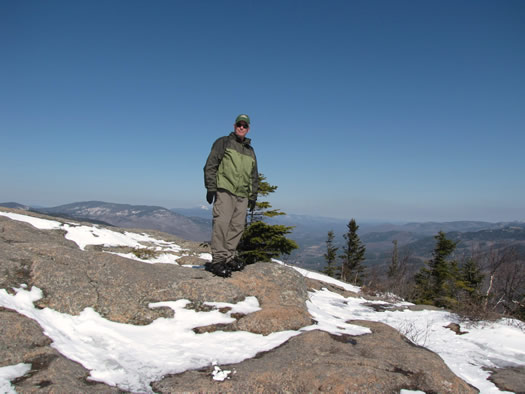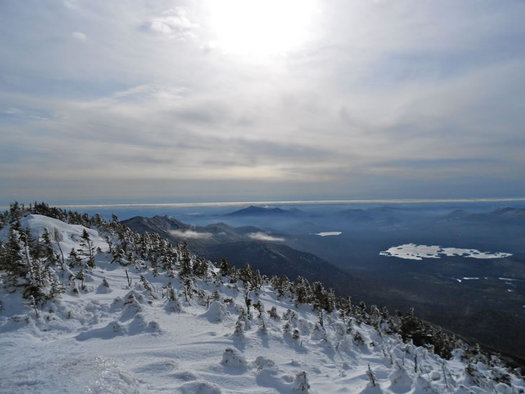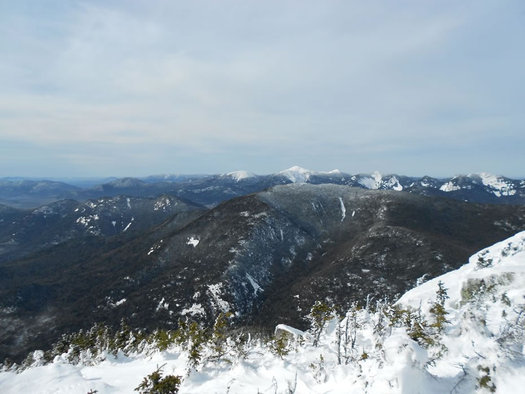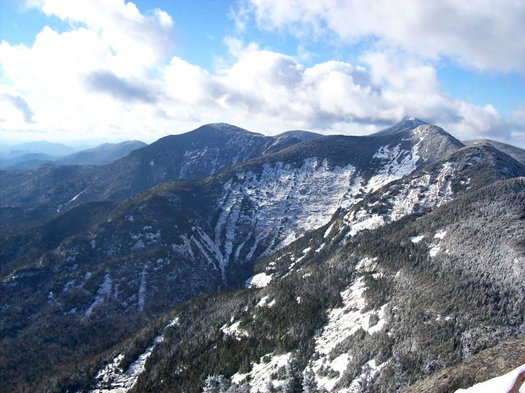The Winter 46ers

A snowy slide on the way to Dix Mountain.
Winter is usually the season where people try to stay indoors as much as possible. The cold, wind, and snow usually drive us into our sweaters and onto our couches.
But not the Winter 46ers. This elite group of fewer than 600 people have climbed all 46 Adirondack High Peaks during winter (December 21 through March 21).
They are, in a word, hardcore.

Ed Sheridan atop Noonmark Mountain.
Ed Sheridan is one of the Winter 46ers. In fact, he's #331. Now 67 years old, Ed climbed his first winter High Peak in 1985. He started with the highest peak in New York, Mt. Marcy. And as is often the case, after one peak, he wanted to climb them all. It took him 15 years to complete his "regular" 46 -- and he finished his winter 46 in 2006.
"We had a business in Bolton Landing, a restaurant, so I could only really hike in the late fall or winter. So on my first go-round with the 46, 15 or so I did in the winter," said Ed. "I realized I had quite a few done in the winter, so why not? I might as well keep going."

From the summit of Dix Mountain.
Records tracking winter high peak climbers date back to the 1890s, but it wasn't until the 1950s that the Adirondack Forty-Sixers started to recognize people for it. Back then, the club awarded a "V Badge" to hikers who had managed to climb just five High Peaks in the winter. It was no small task.
Each peak is over 4,000 ft in elevation. The ascent to the summit can require anywhere from 3 to 8 hours from the trailhead -- and that's in perfect warm weather, enough water, and some experience in hiking. Add to that freezing temperatures, waist-high snow, steep ice-covered rock, and high winds above the tree-line. Hands and feet get cold and lose feeling, water bottles freeze, and unpacked snow can leave you sunk or trapped waist deep. It's quite the journey.

The view of the Great Range from the summit of Dix Mountain.
The first person on record to complete all 46 High Peaks during winter was Edgar B. Bean. In 1962 he finished on Blake Mountain, which is 13.4 miles round trip and can only be reached by climbing over another mountain, Colvin.
As equipment and gear have improved, winter climbing has become a little more comfortable -- and the the number of winter hikers has grown quickly. The Adirondack Forty-Sixers didn't originally want to encourage hikers to climb the High Peaks in the winter because of the risks involved. But the club eventually decided to award people a "Winter 46er" patch to place below their regular 46ers patch and a "W" next to their name on the 46er roster.
"Some of the major trails are actually easier to do in the winter because they're packed down with snow from other hikers," said Ed. So the snow becomes a sort of flat padded road instead of the uneven rocky road of the summer.
But not all of the trails are so kind. One day that stands out in Ed's mind was his ascent on Esther Mountain. She stands off to the side of the greater Whiteface Mountain and is usually not considered that challenging of a climb.
"But that day it was cold, windy and miserable -- probably 15 or 20 below and windy. We did the mountain, but it was awful," said Ed. "We got wet from sweating on the steep ascent and got tired so we slowed down, but then we got cold from going slow. Then the summit was windy so we just froze. We should've just turned around and had a beer at Lake Placid."
For the most part, Ed has strict rules for winter hiking:
+ He always starts at 7 am at the latest. The sun sets at around 4:30 pm in winter, so he makes the most of daylight.
+ His turn around time is always 2 pm. No exceptions. If he's not at the summit by 2, he turns around and heads home. To him, it's not worth hiking the cold trail in darkness.
+ He always takes extra... everything. Gloves, socks, water, layers, etc.
+ If his hands get cold, that's not a good sign. "If I'm near the top I'll keep going, but if not, I'll be miserable. I'm going home."
+ He doesn't go anywhere without his MSR snowshoes or crampons. In fact, in the High Peaks Wilderness, snowshoes are required if snow is 8 inches or deeper. Not having them can result in a citation from the rangers.
+ That Esther hike aside, he won't hike in the extreme cold. "15 degrees is the perfect temperature. You won't sweat enough get wet and cold and the activity will keep you warm. But if it's 15 below, I'm not going anywhere. I'm staying home."
+ He did some of the peaks solo, but doesn't encourage it. "That was really stupid. If anything happens, you're done, you're alone. It's just not safe."
Ed's final winter High Peaks were the trail-less peaks of Seward, Donaldson and Emmons with some friends. And he says he preferred the experience to the regular 46. "It's not hot or muggy, there are no mosquitos, no bugs, the air is clean and crisp and the views are better most of the time."
He hasn't stopped with the High Peaks. Ed just took part in an expedition to Mt. Everest's Base Camp last fall, and he's hiked Kilimanjaro with his wife, Carol.
Though the numbers have grown, compared to the 7,000 or so regular 46ers, the Winter 46ers are a close clan. They meet every year for an annual dinner to catch up, swap stories, and congratulate the newbies.
"Quite a few times you get home after a hike and you're beat, you're tired and you ache all over," said Ed. "And then the next day you think, 'Eh it's not that bad' and you do it again."
____

The view of from Pyramid Peak.
+ There's a book about the history of the Adirondack 46ers called Heaven Up-h'isted-ness!
+ Winter hiking can be dangerous. From the Adirondack Forty-Sixer website:
Only those who are in excellent physical condition, properly equipped and skilled in winter techniques should attempt this, as winter climbing can be demanding and exhausting. Parents should be particularly careful in assessing the abilities of their children. Winter climbers should be familiar with the peaks, weather and seasonal hazards.
Here's an Adirondack Forty-Sixer guide to winter hiking. Also, the Adirondack Mountain Club sponsors a winter mountaineering school that covers skills needed for safe winter climbing.
Earlier on AOA:
+ For the rest of the year: How to hike the High Peaks and not be That Guy
Ed Sheridan photo courtesy of Ed Sheridan
Hi there. Comments have been closed for this item. Still have something to say? Contact us.
Comments
I'm a regular 46R, and that's plenty good for me! The guys that do it in the winter just have to be their own special breed...
... said Slacker on Jan 16, 2013 at 1:36 PM | link
I do not consider myself elite, hardcore or a special breed. I enjoyed hiking the 46 high peaks and when my husband and I finished on October 7 & 8 we had winter like conditions. Since he would be leading hikes for the Shenectady Chapter of the ADK, we decided to be more prepared by taking a weekend course at the Loj. As part of the course we hiked Wright Peak and that led to our hiking in the winter - one of the most wonderful times to hike.
... said Jackie Parker on Jan 16, 2013 at 3:04 PM | link
Very interesting article, thanks for sharing it. Question though: does anyone have any information about (winter) hiking in the Catskills to complement this?
... said Cincinnatus on Jan 17, 2013 at 12:06 AM | link
I'm a winter 46er and Catskill winter 35er. It's a great way to stay in shape during the winter and beat the cabin fever. Unlike Ed from the article, I don't have such strict rules. I don't mind hiking in the dark and don't usually carry crampons.
... said bud on Jan 7, 2014 at 7:26 PM | link